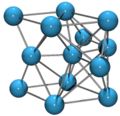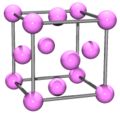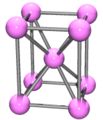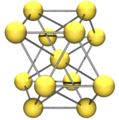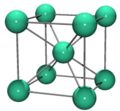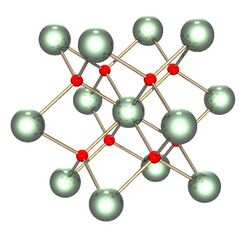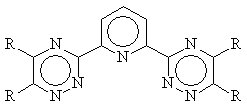Nuclear chemistry
Nuclear chemistry is a subfield of chemistry dealing with radioactivity, nuclear processes and nuclear properties. It includes the study of:
- the chemistry of radioactive elements such as the actinides, radium and radon together with the chemistry associated with equipment (such as nuclear reactors) which are designed to perform nuclear processes. Nuclear reactors can be "high-flux" reactors, mainly used to make radio-active isotopes for medical or scientific use, or "low-flux" reactors, mainly used for power generation. (Flux in this content means the density of neutrons per unit of volume.) These processes include the corrosion of surfaces and the behaviour under conditions of both normal and abnormal operation (such as during an accident). An important area is the behaviour of objects and materials after being placed into a waste store or otherwise disposed of.
- the chemical effects resulting from the absorption of radiation within living animals, plants, and other materials. The radiation chemistry controls much of radiation biology as radiation affects living things at the molecular scale. In particular, radiation alters the biochemicals within an organism, this changes the chemistry within the organism, and this can lead to a biological outcome. Nuclear chemistry is important in the development of some medical treatments (such as cancer radiotherapy).
- the production and use of radioactive sources for many different processes. These include the sources used for radiotherapy; the use of radioactive tracers within industry, science and the environment; and the use of radiation to modify materials such as polymers[6][7] .
- nuclear processes in non-radioactive areas of human activity. For instance, nuclear magnetic resonance (NMR spectroscopy) spectroscopy is commonly used in synthetic organic chemistry and physical chemistry and for structural analysis in macromolecular chemistry.
Early history
After the discovery of X-rays by Wilhelm Röntgen, many scientists began to investigate ionizing radiation. In France, Henri Becquerel investigated the relationship between phosphorescence and the blackening of photographic plates, and he discovered that, with no external source of energy, uranium generated "rays" that could blacken (or fog) a photographic plate. This observation marks the discovery of radioactivity. Subsequently, Marie Curie (working in Paris) and her husband Pierre Curie isolated two new radioactive elements from uranium ore. They used radiometric methods to identify which stream the radioactivity was in after each each chemical separation; they separated the uranium ore into each of the different chemical elements that were known at the time, and measured the radioactivity of each fraction. They then attempted to separate these radioactive fractions further, to isolate a smaller fraction with a higher specific activity (radioactivity per unit mass). In this way, they isolated polonium and radium.
By 1901 it was noticed that high doses of radiation could injure humans. Becquerel had carried a sample of radium in his pocket, and as a result he suffered a high localized dose which resulted in a radiation burn [8] This injury resulted in the biological properties of radiation being investigated, which in time resulted in the development of medical treatments. Marie Curie's daughter (Irène Joliot-Curie) and her husband were the first to create radioactivity: they bombarded boron with alpha particles to make a proton-rich isotope of nitrogen; this isotope emitted positrons. [9] In addition, they bombarded aluminium and magnesium with neutrons to make new radioisotopes.
Ernest Rutherford, working in Canada and England, showed that radioactive decay can be described by a simple equation (a linear first-degree derivative equation, now called first-order kinetics), implying that a given radioactive substance has a characteristic "half life" (the time taken for the amount of radioactivity present in a source to diminish by half). He also coined the terms alpha, beta, and gamma radiation, he converted nitrogen into oxygen, and most importantly he supervised the students who did the Geiger-Marsden experiment (gold leaf experiment) which showed that the "plum pudding model" of the atom was wrong. In the plum pudding model, proposed by J. J. Thomson in 1904, the atom is composed of electrons surrounded by a cloud of positive charge to balance the electrons' negative charge. To Rutherford, the gold foil experiment implied that the positive charge was confined to a very small nucleus, leading first to the Rutherford model and eventually to the Bohr model of the atom, where the positive nucleus is surrounded by the negative electrons.
In initial attempts to make the transuranium elements, uranium was bombarded with neutrons; the idea was that, by creating a neutron-rich uranium isotope, the next element would be formed by beta decay. Instead, in these early studies the fissile 235U underwent fission to generate highly radioactive fission products. Because of their high activity, these fission products (such as short-lived barium isotopes) dominated the radiochemical analysis of the irradiated uranium. At first, it was thought that the uranium had been converted into radium, as many of the early radiochemical methods had difficulty in distinguishing between barium and radium. But gradually it was recognized that most of the radioactivity was due to the products of breaking uranium nuclei into two fragments.[1]
Edwin McMillan attempted to measure the range of the fission products using cigarette paper; during this work he isolated a beta active isotope with a half life of 2.3 days (239Np). A short time later in 1940 plutonium was discovered.
Main areas
Radiochemistry
see radiochemistry for fuller details.
Radiochemistry is the chemistry of radioactive materials, where radioactive isotopes of elements are used to study the properties and chemical reactions of non-radioactive isotopes (often within radiochemistry the absence of radioactivity leads to a substance being described as being inactive as the isotopes are stable). Both the behaviour of man made[2] and natural radioisotopes are part of radiochemistry.
Radiation chemistry
Radiation chemistry is the study of the chemical effects of radiation on matter.This is very different to radiochemistry, as no radioactivity needs to be present in the material which is being chemically changed by the radiation. An example is the conversion of water into hydrogen gas and hydrogen peroxide.
Study of nuclear reactions
see also nuclear physics and nuclear reactions for further details.
A combination of radiochemistry and radiation chemistry is used to study nuclear reactions such as fission and fusion. Some early evidence for nuclear fission was the formation of a shortlived radioisotope of barium which was isolated from neutron-irradiated uranium ( 139Ba, with a half-life of 83 minutes and 140Ba, with a half-life of 12.8 days, are major fission products of uranium). At the time, it was thought that this was a new radium isotope, as it was then standard radiochemical practice to use a barium sulphate carrier precipitate to assist in the isolation of radium.[10]. More recently, a combination of radiochemical methods and nuclear physics has been used to try to make new 'superheavy' elements; it is thought that islands of relative stability exist where the nuclides have half-lives of years, thus enabling weighable amounts of the new elements to be isolated. For more details of the original discovery of nuclear fission see the work of Otto Hahn.
The nuclear fuel cycle
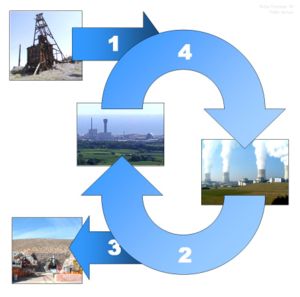
The fuel cycle includes all the operations involved in producing fuel, from mining, ore processing and enrichment to fuel production (Front end of the cycle). It also includes the 'in-pile' behaviour (use of the fuel in a reactor) before the back end of the cycle. The back end includes the management of the used nuclear fuel in either a cooling pond or dry storage, before it is disposed of into an underground waste store or reprocessed. The chemistry associated with any part of the nuclear fuel cycle, including nuclear reprocessing is studied in this part of nuclear chemistry. One of the key topics is the materials used for fuels.
Solid state forms of actinide metals
Most power reactors use dioxide fuel, but some reactor designs do use actinide metal fuel. One of the disadvantages of metal fuel is that the melting point of the fuel is lower than that of either the oxide, nitride or carbide. But for some special applications metal fuel is used, because of this can form general interest a discussion of the crystalography of plutonium metal is provided below. Of the actinides plutonium is the metal which has the most crystal forms, and hence we will restrict our discussion to plutonium.
Many different crystal forms of different actinide metals exist. Plutonium can exist in many different forms, alpha,[3] beta,[4] gamma, delta (ρ = 16.0),[5] delta' (ρ = 16.0),[6] gamma[7] and epsilon [8] forms are known.
The alpha form has a monoclinic cell (a = 6.184, b = 4.824, c = 10.973, alpha = 90o, beta = 101.80o and gamma 90o) with many atoms inside the unit cell, the resulting solid can be thought of consisting of many face sharing distorted tetrahedra. The beta form has a monoclinic cell with many atoms inside the cell, the resulting solid contains tetrahedra and other polyhedra linked together in a face sharing manner. The delta form is a face centred cubic type solid where the cell dimension is 4.632 A. The delta prime form is a tetragonally distorted body centred cubic solid in which the cell dimensions are a = b = 3.339 A and c = 4.446 A.
Solid state structures of actinide dioxides
Many of the actinide dioxides are similar to uranium dioxide, the structure of this is shown below.
Normal and abnormal conditions
The nuclear chemistry associated with the nuclear fuel cycle can be divided into two main areas. One area concerns operation under the intended conditions; the other area concerns maloperation conditions, where some alteration from the normal operating conditions has occurred or (more rarely) during an accident.
Reprocessing
Law
In the USA, it is normal to use fuel once in a power reactor before placing it in a waste store. The long term plan is currently to place the civil used power reactor fuel in a deep store. This policy of not reprocessing was started in March 1977 for nuclear weapons proliferation reasons. President Jimmy Carter issued a Presidential directive which indefinitely suspended the commercial reprocessing and recycling of plutonium in the USA. This directive was probably an attempt by the USA to lead other countries by example, but many other nations continue to reprocess spent nuclear fuels. It is noteworthy that the government under Putin (President of Russia) repealed a law which had banned the inport of used nuclear fuel into Russia, this change in Russian law now permits the Russians to offer a reprocessing service for clients outside Russia (In a similar way to that offered by BNFL).
PUREX chemistry
To separate useful isotopes from fission byproducts, current method of choice is to use the PUREX liquid-liquid extraction process which uses a tributyl phosphate/hydrocarbon mixture to extract both uranium and plutonium from nitric acid.
DUPIC (an alternative)
As an alternative to the use of normal uranium in a CANDU it has been suggested that the spent fuel from a Pressurised Water Reactor could be used in place of natural uranium in a heavy water moderated CANDU. The term DUPIC means Direct Use of spent Pressurized water reactor fuel In CANDU.[11][12] A discussion of different fuel cycles has been published, this includes a discussion of the DUPIC idea.[9]
Old methods (no longer used)
The bismuth phosphate process is a very old process which adds lots of material to the final highly active waste, and which was replaced by solvent extraction processes. The process was designed to extract plutonium from aluminium-clad uranium fuel. The fuel was declad by boiling it in caustic soda. After decladding, the uranium metal was dissolved in nitric acid. The plutonium at this point is in the +4 oxidation state. It was then precipitated by the addition of bismuth nitrate and phosphoric acid to form the bismuth phosphate. The plutonium was co-precipitated with this. The supernatant (containing many of the fission products) was separated from the solid. The precipitate was then dissolved in nitric acid before the addition of an oxidant such as potassium permanganate which converted the plutonium to PuO22+ (Pu VI), then a dichromate salt was added to maintain the plutonium in the +6 oxidation state. The bismuth phosphate was then re-precipitated leaving the plutonium in solution. Then, an iron (II) salt such as ferrous sulfate was added and the plutonium re-precipitated again using a bismuth phosphate carrier precipitate. Then lanthanum salts and fluoride were added to create solid lanthanum fluoride which acted as a carrier for the Pu. This was converted to the oxide by the action of a base. The lanthanum plutonium oxide was then collected and extracted with nitric acid to form plutonium nitrate. [13]
The Hexone or Redoxprocess is a liquid-liquid extraction process which uses methyl isobutyl ketone as the extractant. The extraction is by a solvation mechanism. This process has the disadvantage of requiring a salting-out reagent (aluminium nitrate) to increase the nitrate concentration in the aqueous phase to obtain a reasonable distribution ratio (D value). Also hexone is degraded by concentrated nitric acid. This process has been replaced by PUREX.[14][15]
The Butex, β,β'-dibutyoxydiethyl ether process is based on a solvation extraction process using the triether extractant named above. This process has the disadvantage of requiring the use of a salting out reagent (aluminium nitrate) is required to increase the nitrate concentration in the aqueous phase to obtain a reasonable distribution ratio. This process was used at Windscale many years ago, and has since been replaced by PUREX.
Methods being considered for future use
The PUREX process can be modified to make a UREX (URanium EXtraction) process which could be used to save space inside high-level nuclear waste disposal sites, such as Yucca Mountain, by removing the uranium which makes up the vast majority of the mass and volume of used fuel, and recycling it as reprocessed uranium. The UREX process is a PUREX process which has been modified to prevent the plutonium from being extracted. This can be done by adding a plutonium reductant before the first metal extraction step. In the UREX process, ~99.9% of the uranium and >95% of technetium are separated from each other and the other fission products and actinides. The key is the addition of acetohydroxamic acid to the extraction and scrub sections of the process; this greatly diminishes the extractability of plutonium and neptunium, providing greater proliferation resistance than with the plutonium extraction stage of the PUREX process.
Adding a second extraction agent, octyl(phenyl)-N, N-dibutyl carbamoylmethyl phosphine oxide(CMPO) in combination with tributylphosphate, the PUREX process can be turned into the TRUEX (TRansUranic EXtraction) process, a process invented in the USA by Argonne National Laboratory, and designed to remove the transuranic metals (Am/Cm) from waste. The idea is that, by lowering the alpha activity of the waste, most of the waste can be disposed of easily. Like PUREX, this process uses a solvation mechanism.
As an alternative to TRUEX, an extraction process using a malondiamide has been devised. The DIAMEX (DIAMideEXtraction) process avoids the formation of organic waste which contains elements other than carbon, hydrogen, nitrogen and oxygen. Such an organic waste can be burned without forming acidic gases which could contribute to acid rain. The DIAMEX process is being worked on in Europe by the French CEA. The process is sufficiently mature that an industrial plant could be constructed with the existing knowledge of the process. Like PUREX, this process uses a solvation mechanism.[16][17]
Selective ActiNide EXtraction. As part of the management of minor actinides it has been proposed that the lanthanides and trivalent minor actinides should be removed from the PUREX raffinate by a process such as DIAMEX or TRUEX. In order to allow the actinides such as americium to be either reused in industrial sources or used as fuel the lanthanides must be removed. The lanthanides has large neutron cross sections and hence they would poison a neutron driven nuclear reaction. To date the extraction system for the SANEX process has not been defined, but currently several different research groups are working towards a process. For instance, the French CEA is working on a bis-triaiznyl pyridine (BTP) based process.
References:
- SANEX-BTP Process Studies
- SANEX-BTP Process Development
- Modelling and achievement of a SANEX process
Other systems such as the dithiophosphinic acids are being worked on by some other workers.
This is the UNiversal EXtraction process which was developed in Russia and the Czech Republic; it is designed to remove all of the most troublesome (Sr, Cs and minor actinides) radioisotopes from the raffinates left after extracting uranium and plutonium from used nuclear fuel. [18][19] The chemistry is based upon the interaction of caesium and strontium with polyethylene oxide (polyethylene glycol) [20] and a cobalt carborane anion (known as chlorinated cobalt dicarbollide). The actinides are extracted by CMPO, and the diluent is a polar aromatic such as nitrobenzene. Other dilents such as meta-nitrobenzotrifluoride and phenyl trifluoromethyl sulfone [21]have been suggested as well.
Absorption of fission products on surfaces
Another important area of nuclear chemistry is the study of how fission products interact with surfaces; this is thought to control the rate of release and migration of fission products both from waste containers under normal conditions and from power reactors under accident conditions. It is interesting to note that, like chromate and molybdate, the 99TcO4 anion can react with steel surfaces to form a corrosion-resistant layer. In this way, these metaloxo anions act as anodic corrosion inhibitors. The formation of 99TcO2 on steel surfaces is one effect which will retard the release of 99Tc from nuclear waste drums and nuclear equipment which has been lost before decontamination (e.g. submarine reactors lost at sea). This 99TcO2 layer renders the steel surface passive, inhibiting the anodic corrosion reaction. The radioactive nature of technetium makes this corrosion protection impractical in almost all situations. It has also been shown that 99TcO4 anions react to form a layer on the surface of activated carbon (charcoal) or aluminium.[10][22]. A short review of the biochemical properties of a series of key long lived radioisotopes can be read on line.[23]
It is important to note that 99Tc in nuclear waste may exist in chemical forms other than the 99TcO4 anion, these other forms have different chemical properties.[24] Similarly, the release of iodine-131 in a serious power reactor accident could be retarded by absorption on metal surfaces within the nuclear plant. [11]
Spinout areas
Some methods first developed within nuclear chemistry and physics have become so widely used within chemistry and other physical sciences that they may be best thought of as separate from normal nuclear chemistry. For example, the isotope effect is used so extensively to investigate chemical mechanisms and the use of cosmogenic isotopes and long-lived unstable isotopes in geology that it is best to consider much of isotopic chemistry as separate from nuclear chemistry.
Kinetics (use within mechanistic chemistry)
The mechanisms of chemical reactions can be investigated by observing how the kinetics of a reaction are changed by making an isotopic modification of a substrate. This is now a standard method in organic chemistry. Briefly, replacing normal hydrogen (protons) by deuterium within a chemical compound causes the rate of molecular vibration (C-H, N-H and O-H bonds show this) to decrease. This can lead to a decrease in the reaction rate, if the rate-determining step involves breaking a bond between hydrogen and another atom. Thus, if the reaction changes in rate when protons are replaced by deuteriums, it is reasonable to assume that the breaking of the bond to hydrogen is part of the step which determines the rate.
Uses within geology, biology and forensic science
See Isotope geochemistry and Isotopic signature for further details
Cosmogenic isotopes are formed by the interaction of cosmic rays with the nucleus of an atom. These can be used for dating purposes and for use as natural tracers. In addition, by careful measurement of some ratios of stable isotopes it is possible to obtain new insights into the origin of bullets, ages of ice samples, ages of rocks, and the diet of a person can be identified from a hair or other tissue sample.
Biology
Within living things, isotopic labels (both radioactive and nonradioactive) can be used to probe how the complex web of reactions which makes up the metabolism of an organism converts one substance to another. For instance, green plants use light energy to convert water and carbon dioxide into glucose by photosynthesis. If the oxygen in the water is labeled, then the label appears in the oxygen gas formed by the plant.
For biochemical and physiological experiments and medical methods, a number of specific isotopes have important applications.
- Stable isotopes have the advantage of not delivering a radiation dose to the system being studied; however, an excess of them might still interfere with the system's functioning, and the availability of sufficient amounts for whole-animal studies is limited for many isotopes. Measurement is also difficult, and usually requires mass spectroscopy to determine how much of the isotope is present in particular compounds, and there is no means of localizing measurements within the cell.
- H-2 (deuterium), the stable isotope of hydrogen, is a stable tracer, the concentration of which can be measured by mass spectroscopy or NMR. It is incorporated into all cellular structures. Specific deuterated compound can also be produced.
- N-15 the stable isotope of nitrogen, has also been used. It is incorporated mainly into proteins.
- Radioactive isotopes have the advantages of being detectable in very low quantities, in being easily measured by scintillation counting or other radiochemical methods, and in being localizable to particular regions of a cell, and quantifiable by autoradiography. Many compounds with the radioactive atoms in specific positions can be prepared, and are widely available commercially. In high quantities they require precautions to guard the workers from the effects of radiation--and they can easily contaminate laboratory glassware and other equipment. For some isotopes the half-life is so short that preparation and measurement is difficult.
By organic synthesis it is possible to create a complex molecule with a radioactive label that can be confined to a small area of the molecule. For short-lived isotopes such as 11C, very rapid synthetic methods have been developed to permit the rapid addition of the radioactive isotope to the molecule. For instance a palladium catalysed carbonylation reaction in a microfluidic device has been used to rapidly form amides[12] and it might be possible to use this method to form radioactive imaging agents for PET imaging.[25]
- 3H, Tritium, the radioisotope of hydrogen, it available at very high specific activities, and compounds with this isotope in particular positions are easily prepared by standard chemical reactions such as hydrogenation of unsaturated precursors. The isotope emits very soft beta radiation, and can be detected by scintillation counting.
- 11C, Carbon-11 can be made using a cyclotron, boron in the form of boric oxide is reacted with protons in a (p,n) reaction. An alternative route is to react 10B with deuterons. By rapid organic synthesis, the 11C compound formed in the cyclotron is converted into the imaging agent which is then used for PET.
- 14C, Carbon-14 can be made (as above), and it is possible to convert the target material into simple inorganic and organic compounds. In most organic synthesis work it is normal to try to create a product out of two approximately equal sized fragments and to use a convergent route, but when a radioactive label is added, it is normal to try to add the label late in the synthesis in the form of a very small fragment to the molecule to enable the radioactivity to be localised in a single group. Late addition of the label also reduces the number of synthetic stages where radioactive material is used.
- 18F, fluorine-18 can be made by the reaction of neon with deuterons, 20Ne reacts in a (d,4He) reaction. It is normal to use neon gas with a trace of stable fluorine (19F2). The 19F2 acts as a carrier which increases the yield of radioactivity from the cyclotron target by reducing the amount of radioactivity lost by absorption on surfaces. However, this reduction in loss is at the cost of the specific activity of the final product.
Nuclear magnetic resonance (NMR)
NMR spectroscopy uses the net spin of nuclei in a substances upon energy absorption to identify molecules. This has now become a standard spectroscopic tool within synthetic chemistry. One major use of NMR is to determine the bond connectivity within an organic molecule.
NMR imaging also uses the net spin of nuclei (commonly protons) for imaging. This is widely used for diagnostic purposes in medicine, and can provide detailed images of the inside of a person without inflicting any radiation upon them. In a medical setting, NMR is often known simply as "magnetic resonance" imaging, as the word 'nuclear' has negative connotations for many people.
References
- ↑ Meitner L, Frisch OR (1939) Disintegration of uranium by neutrons: a new type of nuclear reaction. Nature 143:239-40 (doi = 10.1038/224466a0) [1]
- ↑ Imanaka T et al. (2006) J Radiation Research 47 Suppl A121-A127
- ↑ Zachariasen WH, Ellinger FH (1957) J Chem Physics,27:811-2
- ↑ Zachariasen WH, Ellinger FH (1963) Acta Crystallographica 16:369-75
- ↑ Ellinger FH (1956) J Metals, 1956, 8:1256-125
- ↑ Ellinger FH (1956) J Metals 8:1256-125
- ↑ Ellinger FH (1955) Acta Crystallographica 8:431-3
- ↑ Ball JB et al. (1960) Memoires Scientifiques de la Revue de Metallurgie 57:49-56
- ↑ Ko WI, Kim HD (2001) J Nuclear Sci Technol 38:757-65 [2]
- ↑ Decontamination of surfaces, George H. Goodalland Barry.E. Gillespie, United States Patent 4839100
- ↑ Glänneskog H (2004) Interactions of I2 and CH3I with reactive metals under BWR severe-accident conditions Nuclear Engineering and Design 227:323-9
- ↑ Miller PW et al (2006) Chemical Communications 546-548
